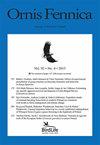Influence of habitat quality and diversity on two populations of Eurasian curlew (Numenius arquata) with contrasting dynamics in Western France
IF 1.2
4区 生物学
Q2 ORNITHOLOGY
引用次数: 0
Abstract
Like most shorebirds in Europe, breeding populations of Eurasian curlew (Numenius arquata) are suffering from habitat loss and degradation mainly caused by changes in agricultural practices. In Deux-Sèvres (France), the number of pairs has gradually declined since the early 2000s in the main, historical breeding site, while a new breeding site has appeared recently 80 kilometres further north with increasing number of pairs through the survey period. Many wheat fields and rare dry grasslands are found in the north, whereas the landscape in the south is mainly composed of tillage plots, hay meadows, and pastures. This study aims to highlight differences in food availability and quality between the two areas. Sample series of ground-dwelling and vegetation-dwelling invertebrates were carried out during three key stages of the species breeding cycle with pitfall traps and sweep nets. Dry grasslands in the north were found to be the most favourable habitat in terms of prey availability for adults and for chicks during the brood-rearing period. Moreover, hay meadows and pastures in the south seemed to be resource-abundant feeding habitats. Therefore, the habitats of the northern site seem to offer a greater abundance of invertebrates and thus a potentially larger food resource than the southern one. It follows that the northern site likely offers better breeding conditions, especially for the growth of chicks. An increase in the area of dry grasslands in the north and the establishment of adapted agricultural management in the south would be favourable for the conservation of local curlew populations.生境质量和多样性对法国西部两个欧亚鸻居群动态对比的影响
与欧洲大多数滨鹬一样,欧亚杓鹬(Numenius arquata)的繁殖种群正遭受栖息地丧失和退化的影响,这主要是由农业实践的变化引起的。在Deux-Sèvres(法国),自2000年代初以来,主要历史繁殖地的配对数量逐渐减少,而最近在更北80公里处出现了一个新的繁殖地,在调查期间配对数量不断增加。北方有许多麦田和罕见的干旱草原,而南方的景观主要由耕地、干草草甸和牧场组成。这项研究旨在强调这两个地区在食物供应和质量方面的差异。在物种繁殖周期的三个关键阶段,用陷阱和清扫网对地面和植被无脊椎动物进行了一系列采样。在育婴期,北方的干燥草原被发现是成虫和雏鸡最有利的猎物栖息地。此外,南部的干草草地和牧场似乎是资源丰富的觅食栖息地。因此,北部栖息地似乎提供了更丰富的无脊椎动物,因此可能比南部更大的食物资源。因此,北部地区可能提供了更好的繁殖条件,尤其是对小鸡的生长。北方干旱草原面积的增加和南方适应农业管理的建立将有利于保护当地的杓鹬种群。
本文章由计算机程序翻译,如有差异,请以英文原文为准。
求助全文
约1分钟内获得全文
求助全文
来源期刊

Ornis Fennica
生物-鸟类学
CiteScore
2.00
自引率
0.00%
发文量
14
审稿时长
>12 weeks
期刊介绍:
Ornis Fennica is a peer-reviewed international ornithological journal published by BirdLife Finland. Ornis Fennica publishes analytical and experimental papers on the ecology, behaviour and biogeography of birds. Ornis Fennica prefers studies concerning Fennoscandian species, but other novel contributions of general interest are most welcome as well.
Ornis Fennica is an open-access journal without page charges for publication. All published articles (from 1924 onwards) are freely available from the journal website. First decisions are usually made within three months of submission.
 求助内容:
求助内容: 应助结果提醒方式:
应助结果提醒方式:


